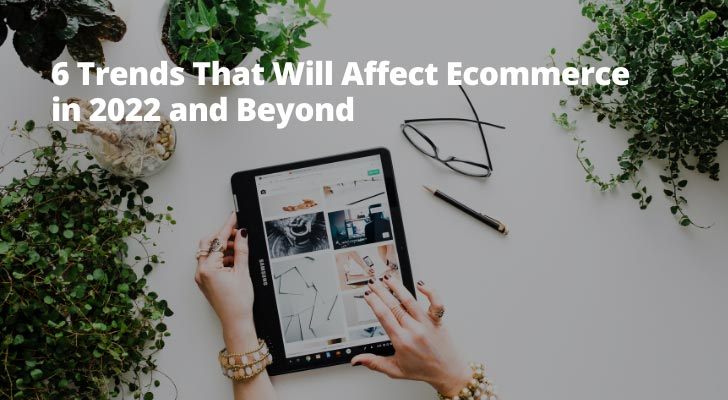The ecommerce industry has not seen this much success as it has in recent years. And if we can trust the projections of experts, the future seems to be pretty bright as well.
The whole thing should not come as a surprise. After all, people are shopping online more than ever, and there is a real risk to brick-and-mortar stores that you might still find around the corner. Whether online shopping can eliminate physical stores completely is still too early to tell, but it is pretty clear who is coming out on top.
It is also worth noting that the pandemic also played a prominent role in boosting online sales (it still does, by the way). Even those who have not purchased goods or services online had to change their stance, and this led to the discovery of how convenient ecommerce is.

Now, while the ecommerce industry is on the rise, it is important to note that it is not stopping anytime soon. If anything, there are multiple trends that are affecting the approach of both shoppers and business owners.
For someone who might be thinking about starting an ecommerce store from home themselves, it is necessary to know the ins and outs of the business to increase the odds of success.
Let’s take a look at some of the ecommerce trends and get a better understanding of what we should look out for right now and in the next few years.
1. Custom Merchandise
The promotion of an online store depends on what the owner prefers. There are different approaches. Some like to focus on social media and influencer marketing, whereas others invest heavily in search engine optimization and PPC marketing.
Having said that, attracting new customers is only the first step. You also have to convince them to purchase the goods or services and even return.
Loyalty is a difficult thing to achieve, particularly when there are so many different online stores available.
Offering various perks is a common strategy to build customer loyalty. The trend stems from the fact that for many stores, it is harder to find new customers than retain old ones. Therefore, you will see businesses offer freebies, such as custom t shirts or mugs, for returning shoppers or first-time customers who commit a certain amount of product value in their shopping cart.
Branded merchandise also works as a means of raising awareness. Having someone wear a shirt with a brand’s logo means free advertisement.
Even if you are a small business owner operating from home, you can still arrange for custom merchandise to be made on your behalf. And you do not even have to worry about warehousing or inventory because a good supplier does more than just manufacture the merch. It will also deliver it to your customer so long as you arrange everything properly.
2. Virtual Reality

If you run an online store from home, you are unlikely to invite every customer to your home to check the goods. Inviting them to a warehouse where you keep everything is also an unlikely occurrence.
Online shoppers rely on recommendations from their friends and family when they purchase something on the internet for the first time. Reviews from other customers are also a good source, but trusting a word of a stranger is not necessarily a good approach.
While ecommerce has many upsides, it still comes with certain downsides. One of the most notable drawbacks of shopping online is that you cannot try the goods yourself in person before they arrive at your doorstep.
For instance, if you want to purchase new furniture or clothes, you would like to test them first, right?
The obstacle might be possible to circumvent in the future. The idea of offering customers a virtual reality experience is not something that every online store can accomplish yet for two reasons.
The first is that there is no telling how much you have to invest in optimizing the entire thing. For someone who works from home and is operating on a limited budget, setting up a VR feature is one for the future when the whole concept becomes cheaper.
The second reason is that the majority of shoppers do not have virtual reality goggles, so they would not be able to utilize the opportunity if it existed.
Nevertheless, given how much ecommerce and online shopping have advanced from their early days, it is only a matter of time before virtual reality shopping becomes just as common as purchasing goods and services on your smartphone.
Supercharge Your AWeber Account
Take Your Email Marketing To The Next Level With These Powerful Tools
3. Chatbots
Running an online store on yourself is more or less impossible because it pretty much needs maintenance 24/7. When you start from scratch and build up a decent-sized business, you will need to seek help, particularly when it comes to keeping an eye on the website and security threats.
Another important aspect of an online shop is customer support. Shoppers who have questions and cannot find answers themselves will seek help from customer support. There should be a live chat button on the website, and after submitting their messages, shoppers expect timely responses.
As someone who is managing an online store from home, you might have more time and opportunities to check the customer support inbox. However, can you realistically respond to every query and still have enough time to take care of other matters related to the business? Unlikely.
There is a potential way to circumvent the issue - chatbots. The trend to see chatbots replace real people in customer support should not come as a surprise.
So long as a chatbot is working properly, it can respond to customer questions immediately and do so 24/7. In addition, thanks to smart algorithms, chatbots used in customer support learn and adapt to customer behavior, which makes them even more effective.
4. Mobile Optimization

Mobile optimization should be a given since roughly 50 percent of all online traffic comes from smartphones and tablets.
Online shopping is also quite comfortable when you can do it on a mobile device. Checking for a product online without needing to go to your computer and doing it on a smartphone instead saves time.
As someone who is working from home and managing their online store, you need to ensure that the site is accessible to as many different mobile devices as you can.
It is likely that you are using a specific mobile-friendly theme on your website. Keep an eye on updates and make sure that you install them.
Because more and more people are getting smartphones and tablets for their everyday tasks, which include shopping, it is crucial to be at the top of your game and provide a positive experience for mobile users. Otherwise, you will miss out on potential customers.
One final thing to note about the mobile optimization trend for an ecommerce business is that you might want to consider a native iOS and Android app for your store. App development is a heavy investment, especially if you decide to learn the coding intricacies yourself, but it should still be one of your considerations long-term if you want a successful ecommerce business.
5. Payment Gateways
Customers appreciate multiple ways to pay for goods or services. The downside to it as an online store owner is that you have to manage multiple payment gateways. It is much easier to keep track of everything if, say, you use only PayPal and bank transfers via credit cards.
As soon as you introduce other platforms, such as Payoneer, Skrill, Stripe, and even cryptocurrency, the workload on accounting adds up, and it complicates things if you have to manage that part of the business yourself.
However, when you consider abandoned shopping carts, the lack of payment options is one of the most common reasons behind it, together with a long and overcomplicated checkout process.
If necessary, you will have to hire extra help for managing all the payments for your store. Variety in payment options is another prominent trend, and it will not disappear anytime soon. If anything, we should expect to see even more different payment options. And unless you adopt them, your competition that does it will have one extra advantage over you.
6. Video Content
Customers respond to video content. If there is one current staple in marketing campaigns, it is seeing how walls of text have been replaced with visuals. Not only videos, but images, GIFs, short animations, and infographics are easier to digest for an average person.
Because of our current lifestyle, the attention span of an average person dropped significantly over the last two decades or so, meaning that reading a text until the end is much harder than watching a video or looking at an image.
Videos are great for explaining and showcasing products. Even if you have to do it yourself with amateur video editing tools and skills, you will still have a better result than you would with instructions consisting of walls of text.
And as you create and edit more explanation videos for your online stores, you will only improve. Not to mention that you will also gain a valuable skill that can be used in other opportunities working from home.
What Do You Advocate?
